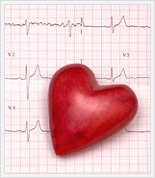 |
Already a member? Secure Login
|

- Ideal Weight Calculator
- Waist-to-Hip Ratio Calculator
- BMI Calculator
- Frame Size Calculator
- Target Heart Rate Calculator

- Good Fast Food
- Recipe Makeovers
- Meal Plans
- Nutrient Facts
- Food Label Claims
- Estimating Serving Sizes



Target Heart Rate
QUESTION:
I keep hearing about exercising in the target heart rate zone. How do I figure this out, and how important is it?
I keep hearing about exercising in the target heart rate zone. How do I figure this out, and how important is it?
ANSWER:
 Your target heart rate zone is a range of heart rates that reflect your level of intensity. During exercise, it is beneficial to be at an intensity that is just right: not too easy and not too hard. Although it is not imperative that you monitor your heart rate during exercise, doing so is one way to let you know if you are working out at an appropriate intensity. A desired intensity will be hard enough to benefit your heart, lungs, muscles and bones, while not being so intense as to risk injury to your body.
Your target heart rate zone is a range of heart rates that reflect your level of intensity. During exercise, it is beneficial to be at an intensity that is just right: not too easy and not too hard. Although it is not imperative that you monitor your heart rate during exercise, doing so is one way to let you know if you are working out at an appropriate intensity. A desired intensity will be hard enough to benefit your heart, lungs, muscles and bones, while not being so intense as to risk injury to your body.Target heart rate zones are based on a percentage of the maximum rate that your heart can beat per minute. This maximal rate of the heart is known as "maximal heart rate". Individuals that have had a maximal exercise stress test will obtain their actual maximal heart rate from the test results. This can be very beneficial because maximum heart rates can vary tremendously depending on factors such as age, prescription drugs, and disease states. However, most individuals have not performed this exercise test so there is a formula to estimate maximal heart rate.
Use the following equation to calculate your maximal heart rate:
207 - (0.7 x age) = maximal heart rate in beats per minute (bpm)
As we age, maximal heart rate declines. Therefore, age is an important factor when estimating maximal heart rate. Another popular equation is (220-age). However, research has shown it to be less accurate than the recommended equation above.
Once you know your maximal heart rate, you can determine a target range of heart rates that is ideal for you to maintain during exercise. Typically, exercise prescriptions will provide a range somewhere between 60 to 90 % of maximal heart rate. This range corresponds to the intensities of moderate to hard. For example, if your maximal heart rate was 194, multiply 194 by 0.6 and 0.9 to get the lower and upper limits of your target heart rate zone.
194 x 0.6 and 194 x 0.9 = a target heart rate zone of 124 to 186 beats per minute (bpm).
Beginners should exercise at the lower end of this range and increase intensity slowly as the body becomes more conditioned to exercise. Consulting with an exercise specialist can help you individualize this range further to aid you in achieving specific personal goals. In general, an appropriate intensity is one that meets your goals of caloric expenditure for a given amount of time, challenges your current fitness state, and is safe and tolerable.
| Related Articles: |
 |
Our expert, Dr. Sharon E. Griffin, holds a B.S., M.S., and Ph.D. in the areas of exercise science/physiology. She also holds a second M.S. degree in Nutrition and is a licensed nutritionist and an ACSM certified health and fitness instructor.
© 2025 MyFoodDiary.com. All Rights Reserved.